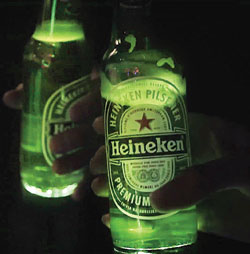Packaging with Pizazz; Transforming Cellulose Into Amylose
CUTTING EDGE TECHNOLOGY
Packaging with true pizazz
 Marketers are continually looking for ways to keep their brands relevant to consumers’ changing lifestyles. For Heineken, the brewer was looking to create a memorable beer-drinking experience using mobile innovation and technology that marries product and packaging (iconic green glass bottle) with its social environment, such as a bar or music club.
Marketers are continually looking for ways to keep their brands relevant to consumers’ changing lifestyles. For Heineken, the brewer was looking to create a memorable beer-drinking experience using mobile innovation and technology that marries product and packaging (iconic green glass bottle) with its social environment, such as a bar or music club.
Called Heineken Ignite, the project relied upon the “Spark” process developed by Tribal DDB, a global network of interactive agencies. The fast-track process, which was accomplished in only 10 weeks, included research, ideation, development, consumer validation, and prototyping. The creative team included the Global Heineken Digital team and Tribal DDB Amsterdam, along with partners Massive Music, Contagious, C10, and independent experts from a wide range of industries.
The result of their labors was a “smart” beer bottle that can interact with other bottles, its environment, and the people around it. The Ignite bottle uses micro sensors and wireless networking technology to sense the moment when a bottle is being used to say “cheers” (e.g., clinking two bottles at the neck). The bottle can also actively respond to the music and the output of specific audio and data cues. For example, it can detect various motion types such as cheering, sipping/drinking, and sitting idle on the bar top. The motions trigger certain lighting effects that illuminate the entire bottle, enhanced by the swirls of beer, carbon dioxide, and oxygen. In addition, the bottle lights can be remotely activated and synchronized to music beats in a club setting.
The 3D printed housing (designed and developed by C10) under the bottle base includes a custom-designed circuit board with eight bright LEDs, an efficient 8-bit microprocessor, an accelerometer to detect various motions, and a wireless network transceiver to communicate with other devices. The two-part housing (a little bigger in diameter than a 2 Euro coin) enables it to be reused on multiple bottles of beer.
Heineken Ignite had its coming out party at the recent Milan Design Fair, where 200 prototypes were on display.
Enzymes convert cellulose into amylose starch
Many foodies prefer salmon cooked on a plank, which adds flavor notes (depending on the type of wood) to the fish. Thanks to researchers at Virginia Tech, you may one day be able to “eat” the plank as well. A team of Virginia Tech researchers—led by Y.H. Percival Zhang, Associate Professor of Biological Systems Engineering in the College of Agriculture and Life Sciences and the College of Engineering—has succeeded in converting cellulose into starch.
Zhang used a novel process involving cascading enzymes to transform cellulose into amylose starch. Amylose, a linear resistant starch, is not broken down in the digestion process and acts as a good source of dietary fiber. “Cellulose and starch have the same chemical formula,” explained Zhang. “The difference is in their chemical linkages. Our idea is to use an enzyme cascade to break up the bonds in cellulose, enabling their reconfiguration as starch.”
The new approach takes cellulose from nonfood plant material, such as corn stover, converts about 30% to amylose, and hydrolyzes the remainder to glucose suitable for ethanol production. The bioprocess, which works with cellulose from any plant and is known as “simultaneous enzymatic biotransformation and microbial fermentation”, can be scaled up for commercial production. The environmentally friendly process does not require expensive equipment, heat, or chemical reagents, and does not generate any waste. The key enzymes immobilized on the magnetic nanoparticles can be recycled using a magnetic force.
The process that has the potential to provide a previously untapped nutrient source from plants not traditionally thought of as food crops. Furthermore, it may reduce the need for crops to be grown on valuable land that requires fertilizers, pesticides, and large amounts of water. Cellulose is the supporting material in plant cell walls and is the most common carbohydrate on earth. Starch is one of the most important components of the human diet and provides 20–40% of caloric intake. The research, “Enzymatic transformation of nonfood biomass to starch”, was published in the Proceedings of the National Academy of Sciences of the United States of America.
If you are working on or know of some cutting edge technology that you would like to be featured in this column, please send an email to [email protected].
